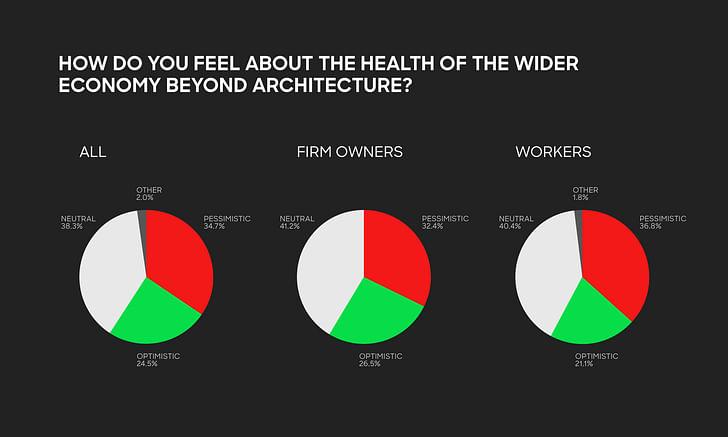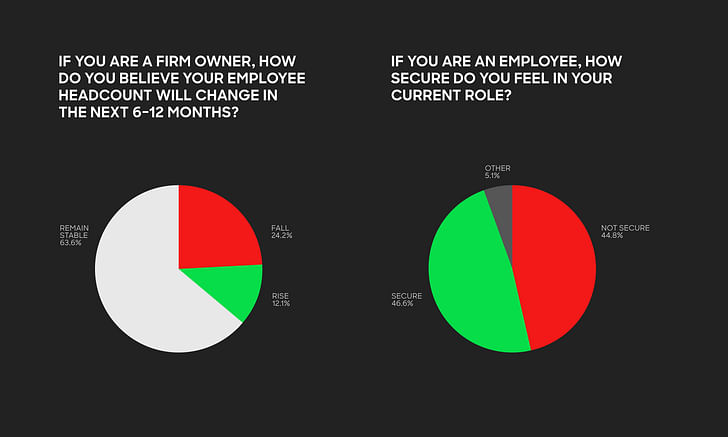

In our recent analysis of the Archinect Business Survey published last month, we observed a distinct divergence between how firm owners and workers were feeling about the business health of their firm, industry, and the wider U.S. economy. Across the board, our survey suggests that firm workers felt more pessimistic and insecure about today’s economic landscape than firm owners. Why?
There is likely no ‘one size fits all’ answer to this question. However, a number of trends playing out across the economy, including architecture-specific trends previously reported by Archinect, offer several lines of speculation.
Last month, we released the results of the Archinect Business Survey, which asked the architectural community for their views and experiences on the business landscape of 2024. Survey respondents painted a muted picture of the profession, with most architects feeling either neutral or pessimistic about the economic health of their firm, the industry, and the broader U.S. economy.
One of the most frequent trends in our analysis of the survey was the differing sentiments between architectural employers and employees, expressed as ‘firm owners’ and ‘workers’ in the survey. Across the board, firm workers felt more pessimistic and insecure about today’s economic landscape than firm owners.
As our analysis found, workers were half as likely as firm owners to say they were optimistic about their firm’s health and 13% more likely to say they were pessimistic. Workers were significantly more downbeat about the industry’s health than owners, with a majority (66%) of workers expressing pessimism versus a plurality (47%) of owners. Workers were also more downbeat about the wider economy than firm owners were, though the difference was not as extreme as those about the architecture industry.
The discrepancies continued when our survey dug deeper into what respondents had observed within their own firms and lives. While 20% of owners said their firm’s health had improved over the past year, only 3% of workers shared the same sentiment. In addition, half of firm owners said their firm’s health had declined in the past year, versus over 65% of workers. When we asked respondents how prepared they were if the U.S. fell into a recession, workers were over 20% more likely to say they were unprepared versus firm owners. Finally, workers were twice as likely to say they were not secure in their role as firm owners were to say that they were planning to reduce their employee headcount.

It is worth noting that, as with any poll, our survey was a snapshot in time, receiving over 100 responses between May and June 2024. Our findings nonetheless raise a clear question: Why do architecture workers in our survey appear more concerned about the economy than firm owners?
There is likely no ‘one size fits all’ answer to this question. However, a number of trends playing out across the economy, including architecture-specific trends previously reported by Archinect, offer two distinct lines of speculation.
The first relates to the differing roles and interests between firm owners and workers. Inevitably, firm owners will have a more complete picture of their business finances than workers, including a deeper understanding of future work pipelines and sources of credit. Of course, the reality of a firm’s business health may be poorer than that which workers speculate on, but the mere ability of owners to form that clear picture without speculation may also be enough to lessen feelings of foreboding and helplessness. As the maxim goes: ‘Knowledge is power.’
The higher feelings of pessimism experienced by workers are instead expressed in areas where firm owners have access to more privileged information, such as the health of their firm and industry.
To that end, it is interesting to note when our survey asked respondents for their feelings on the health of the wider economy beyond architecture, which both owners and workers are more likely to witness in equal measure, the gap between the two groups narrows substantially. The higher feelings of pessimism experienced by workers are instead expressed in areas where firm owners have access to more privileged information, such as the health of their firm and industry.

In addition to having a more complete picture of their firm’s health, owners also hold more control than workers over the future direction of the firm. While the ability to control the destiny of the firm may instill a greater sense of optimism within owners, a contrasting lack of control over the business may instill in the worker feelings of helplessness and vulnerability, expressed in our survey through heightened pessimism, and a feeling of workplace decline. Finally, while firm owners are undoubtedly exposed to the anxiety of their business ultimately failing, their workers will often fall victim to job losses before this eventuality.
This speculation is supported by polling data from Gallup, which recently found that U.S. workers are becoming “more detached from their employers, with less clear expectations, lower levels of satisfaction with their organization, and less connection to its mission or purpose than they did four years ago.” Gallup also found that employees are becoming less likely to feel that someone at work cares about them as a person.
As Archinect has explored in-depth over the past two years, feelings of disempowerment, a lack of agency and control, and deteriorating workplace conditions have also been central drivers of renewed unionization efforts in firms across the United States. “There is a tremendous amount of wasted work which we pretend is part of the design process but is instead the product of poor communication and management,” union organizer and former SHoP worker Andrew Daley told us in our previous deep dive on the movement. “There is something wrong with the architecture business model, and clearly, those in management do not want to have that conversation at its face.”
Furthermore, the trends in our survey may also be influenced in part by the makeup of the architecture community. As often seen in online community discourse, such as the Archinect Forum, workers are more likely to share experiences during pessimistic times, while firm owners appear more engaged during optimistic times. Therefore, the survey may be skewed with more worker participation from struggling firms and owner engagement from healthy firms.

Our second line of speculation on the difference in feelings between firm owners and workers in our survey centers on generational gaps. Given the years of experience required to establish an architecture office, perhaps preceded by years climbing the ladder of another practice, firm owners are often (though not always) older than many of their workers. Returning to our previous maxim that ‘knowledge is power,’ firm owners are therefore more likely to have experienced previous recessions than workers, particularly those who entered the profession after the 2008 crash.
Younger generations of architectural workers are also often forced to confront the dual struggle of low salaries and high student debt, making them acutely sensitive to economic forces such as inflation and wage stagnation.
Experiences of previous recessions may therefore be a factor for our survey’s finding that workers feel significantly less prepared for a recession than firm owners, and are more likely to feel insecure in their jobs than firm owners are to feel their employee headcount will fall.
Workers entering the profession are also facing a different economic reality than previous generations. While reporting suggests that younger generations have gained more wealth than other age groups since 2019, those under 40 are still the poorest of the generations. In addition, the spread of wealth within younger generations is becoming more unequal. As our editorial often reports, younger generations of architectural workers are also often forced to confront the dual struggle of low salaries and high student debt, making them acutely sensitive to economic forces such as inflation and wage stagnation.

Heightened pessimism among workers about their firm and industry may serve as a prompt for firm owners to offer increased insights or autonomy to their staff, not only for the well-being of the worker but for the well-being of the firm. The same Gallup poll that found a growing disengagement among the U.S. workforce noted that “not engaged or actively disengaged employees account for approximately $1.9 trillion in lost productivity nationally,” while a 2019 University of Oxford study found that happy workers are 13% more productive than unhappy workers.
“There seems to be considerable room for improvement in the happiness of employees while they are at work,” said study author Professor Jan-Emmanuel De Neve. “While this is clearly in the interest of workers themselves, our analysis suggests it is also in the interests of their employers.”
Has your architecture firm observed differences in sentiment about the economy among your colleagues? Let us know in the comments. Meanwhile, you can learn more about the recent Archinect Business Survey by reading Part 1 and Part 2 of our analysis.
Niall Patrick Walsh is an architect and journalist, living in Belfast, Ireland. He writes feature articles for Archinect and leads the Archinect In-Depth series. He is also a licensed architect in the UK and Ireland, having previously worked at BDP, one of the largest design + ...
No Comments
Block this user
Are you sure you want to block this user and hide all related comments throughout the site?
Archinect
This is your first comment on Archinect. Your comment will be visible once approved.